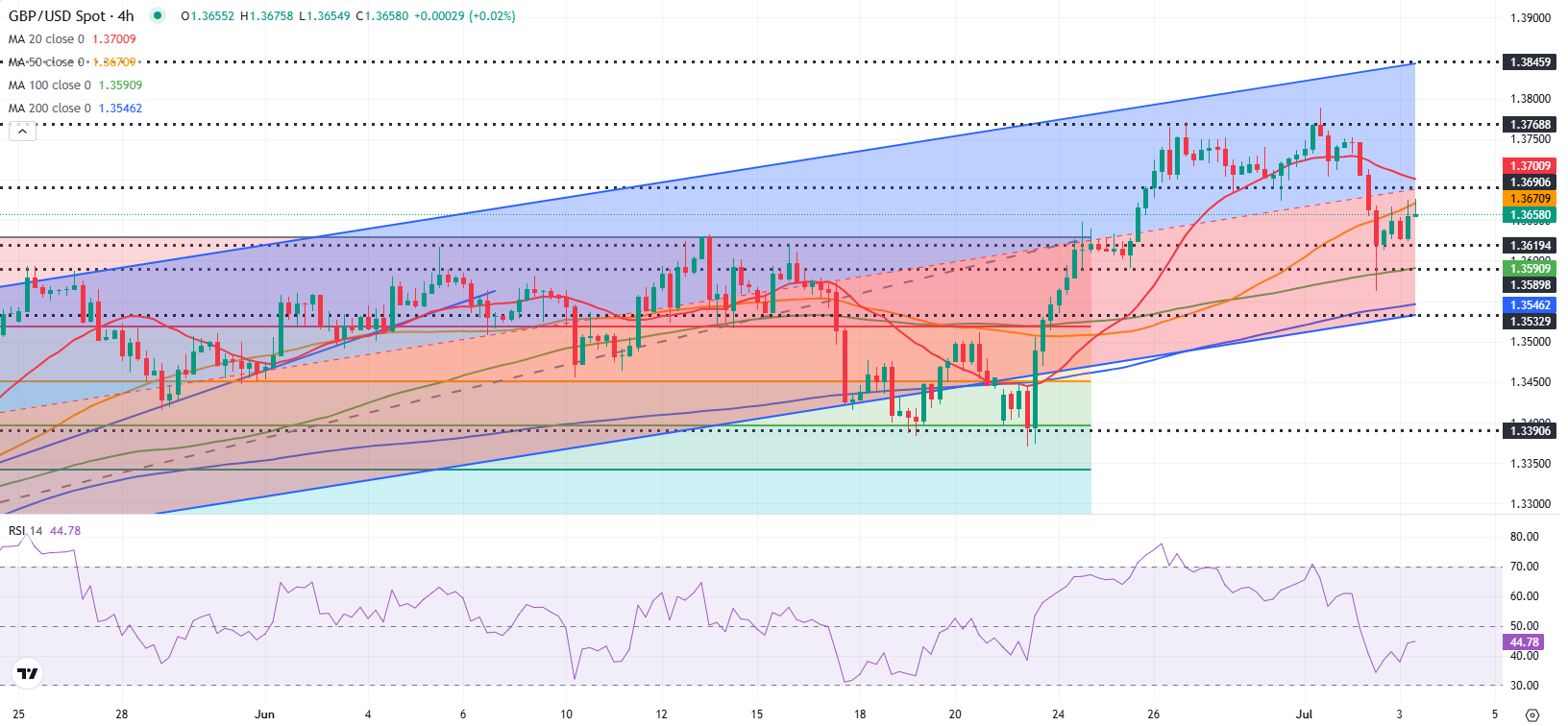
- Political jitters in the UK weighed heavily on Pound Sterling on Wednesday.
- The near-term technical outlook highlights a lack of bullish momentum.
- The US economic calendar will feature Nonfarm Payrolls data for June.
GBP/USD came under heavy bearish pressure on Wednesday and lost about 0.8%. The pair stages a rebound early Thursday but trades well below 1.3700. Markets will keep a close eye on political developments in the UK and scrutinize the June employment report from the US.
British Pound PRICE This week
The table below shows the percentage change of British Pound (GBP) against listed major currencies this week. British Pound was the weakest against the Swiss Franc.
| USD | EUR | GBP | JPY | CAD | AUD | NZD | CHF | |
|---|---|---|---|---|---|---|---|---|
| USD | -0.51% | 0.40% | -0.35% | -0.74% | -0.57% | -0.30% | -0.77% | |
| EUR | 0.51% | 0.89% | 0.19% | -0.23% | -0.07% | 0.22% | -0.26% | |
| GBP | -0.40% | -0.89% | -0.88% | -1.12% | -0.96% | -0.68% | -1.15% | |
| JPY | 0.35% | -0.19% | 0.88% | -0.40% | -0.18% | 0.08% | -0.38% | |
| CAD | 0.74% | 0.23% | 1.12% | 0.40% | 0.12% | 0.43% | -0.03% | |
| AUD | 0.57% | 0.07% | 0.96% | 0.18% | -0.12% | 0.28% | -0.19% | |
| NZD | 0.30% | -0.22% | 0.68% | -0.08% | -0.43% | -0.28% | -0.47% | |
| CHF | 0.77% | 0.26% | 1.15% | 0.38% | 0.03% | 0.19% | 0.47% |
The heat map shows percentage changes of major currencies against each other. The base currency is picked from the left column, while the quote currency is picked from the top row. For example, if you pick the British Pound from the left column and move along the horizontal line to the US Dollar, the percentage change displayed in the box will represent GBP (base)/USD (quote).
British Prime Minister Keir Starmer’s refusal to guarantee that finance minister Rachel Reeves will remain in her position until the next election triggered a selloff in UK government bonds during the European session on Wednesday, causing Pound Sterling to weaken against its major rivals.
Late Wednesday, Starmer said that Reeves would remain chancellor “for a very long time to come,” easing concerns over a political turmoil. In response, the 10-year UK gilt yield started to correct lower early Thursday after rising nearly 4% on Wednesday and helped GBP/USD find support.
Later in the day, the US Bureau of Labor Statistics is forecast to report an increase of 110,000 in Nonfarm Payrolls (NFP) in June.
According to the CME Group FedWatch Tool, markets are currently pricing in about a 25% probability of the Federal Reserve (Fed) cutting the policy rate by 25 basis points in July. Hence, a positive surprise in NFP, with a print above 150,0000, could confirm a Fed policy-hold in July and help USD gather strength ahead of the July 4 holiday. Conversely, a disappointing reading below 80,000 could hurt the USD with the immediate reaction and open the door for an extended recovery in GBP/USD.
GBP/USD Technical Analysis

GBP/USD stays slightly below the 50-period Simple Moving Average (SMA) and the Relative Strength Index (RSI) indicator remains below 50, reflecting a lack of bullish momentum.
On the downside, 1.3620 (static level) aligns as the next support level before 1.3590 (100-period SMA) and 1.3550 (200-period SMA). Looking north, resistance levels could be spotted at 1.3690-1.3700 (mid-point of the ascending channel, static level), 1.3770 (static level) and 1.3800 (static level, round level).
Pound Sterling FAQs
The Pound Sterling (GBP) is the oldest currency in the world (886 AD) and the official currency of the United Kingdom. It is the fourth most traded unit for foreign exchange (FX) in the world, accounting for 12% of all transactions, averaging $630 billion a day, according to 2022 data. Its key trading pairs are GBP/USD, also known as ‘Cable’, which accounts for 11% of FX, GBP/JPY, or the ‘Dragon’ as it is known by traders (3%), and EUR/GBP (2%). The Pound Sterling is issued by the Bank of England (BoE).
The single most important factor influencing the value of the Pound Sterling is monetary policy decided by the Bank of England. The BoE bases its decisions on whether it has achieved its primary goal of “price stability” – a steady inflation rate of around 2%. Its primary tool for achieving this is the adjustment of interest rates. When inflation is too high, the BoE will try to rein it in by raising interest rates, making it more expensive for people and businesses to access credit. This is generally positive for GBP, as higher interest rates make the UK a more attractive place for global investors to park their money. When inflation falls too low it is a sign economic growth is slowing. In this scenario, the BoE will consider lowering interest rates to cheapen credit so businesses will borrow more to invest in growth-generating projects.
Data releases gauge the health of the economy and can impact the value of the Pound Sterling. Indicators such as GDP, Manufacturing and Services PMIs, and employment can all influence the direction of the GBP. A strong economy is good for Sterling. Not only does it attract more foreign investment but it may encourage the BoE to put up interest rates, which will directly strengthen GBP. Otherwise, if economic data is weak, the Pound Sterling is likely to fall.
Another significant data release for the Pound Sterling is the Trade Balance. This indicator measures the difference between what a country earns from its exports and what it spends on imports over a given period. If a country produces highly sought-after exports, its currency will benefit purely from the extra demand created from foreign buyers seeking to purchase these goods. Therefore, a positive net Trade Balance strengthens a currency and vice versa for a negative balance.
Information on these pages contains forward-looking statements that involve risks and uncertainties. Markets and instruments profiled on this page are for informational purposes only and should not in any way come across as a recommendation to buy or sell in these assets. You should do your own thorough research before making any investment decisions. FXStreet does not in any way guarantee that this information is free from mistakes, errors, or material misstatements. It also does not guarantee that this information is of a timely nature. Investing in Open Markets involves a great deal of risk, including the loss of all or a portion of your investment, as well as emotional distress. All risks, losses and costs associated with investing, including total loss of principal, are your responsibility. The views and opinions expressed in this article are those of the authors and do not necessarily reflect the official policy or position of FXStreet nor its advertisers. The author will not be held responsible for information that is found at the end of links posted on this page.
If not otherwise explicitly mentioned in the body of the article, at the time of writing, the author has no position in any stock mentioned in this article and no business relationship with any company mentioned. The author has not received compensation for writing this article, other than from FXStreet.
FXStreet and the author do not provide personalized recommendations. The author makes no representations as to the accuracy, completeness, or suitability of this information. FXStreet and the author will not be liable for any errors, omissions or any losses, injuries or damages arising from this information and its display or use. Errors and omissions excepted.
The author and FXStreet are not registered investment advisors and nothing in this article is intended to be investment advice.







